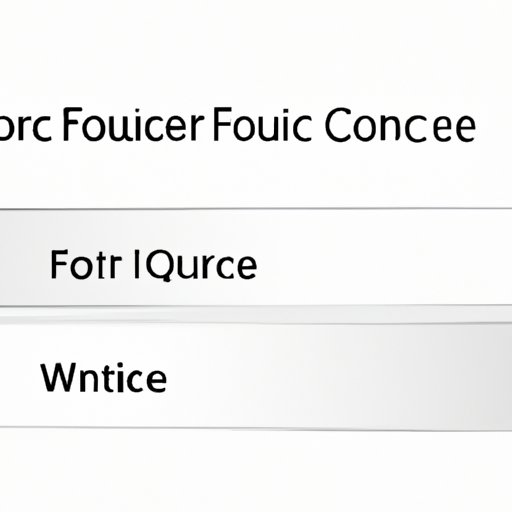I. Introduction
Have you ever experienced a frozen application that won’t close no matter how many times you click the close button? This can be a frustrating experience for any computer or mobile device user. Luckily, force quitting can be an easy solution to this problem. This article will serve as a comprehensive guide to force quitting on Windows, Mac, and Android devices. We will cover step-by-step instructions, keyboard shortcuts, troubleshooting tips, and alternative solutions to help you end unresponsive programs with ease.
II. A Simple Guide to Force Quitting on Windows
To force quit an unresponsive program on Windows, you’ll need to access the Task Manager. There are a few ways to do this:
- Right-click on the taskbar and select “Task Manager”
- Press the Ctrl + Shift + Esc keys on your keyboard
- Press the Ctrl + Alt + Delete keys and select “Task Manager”
Once you’re in the Task Manager, locate the unresponsive program under the “Processes” or “Details” tab. Click on it and select “End Task”. If this doesn’t work, right-click on the program and select “End Process Tree”. This will force quit the program and any associated processes.
III. The Ultimate Guide to Force Quitting on Mac
Mac users can also experience frozen applications, commonly known as “the spinning beach ball of death”. To force quit an unresponsive program on a Mac, follow these steps:
- Press and hold the Command + Option + Esc keys on your keyboard
- Select the unresponsive program from the list of open applications
- Click “Force Quit”
If this method doesn’t work, you can try to force quit using the Activity Monitor. To access this, go to Applications > Utilities > Activity Monitor. Locate the unresponsive program, click on it, and select the “X” button in the upper-left corner of the window. This will force quit the program.
IV. Locked Up in Your Browser? Try These Ways to Force Quit Google Chrome and Mozilla Firefox Safely
If your browser freezes up, it can be especially frustrating. Here are some tips for safely force quitting your browser:
- Windows users: Press the Ctrl + Shift + Esc keys on your keyboard to open the Task Manager. Locate your browser under the “Processes” or “Details” tab and select “End Task”.
- Mac users: Press the Command + Option + Esc keys to open the Force Quit Applications window. Select your browser and click “Force Quit”. Alternatively, you can force quit using the Activity Monitor method mentioned in section III.
If force quitting your browser doesn’t solve the problem, try clearing your cache and cookies or disabling any extensions that may be causing issues.
V. Power Off, Force Stop, or Shut Down? How to Force Quit Applications on Android Phones and Tablets
Force quitting on Android devices varies depending on the make and model of your device. Here are some general steps to follow:
- Open the “Settings” app on your device
- Go to “Apps” or “Application Manager”
- Scroll to find the unresponsive app and tap on it
- Select “Force Stop”
Alternatively, you can try pressing and holding the power button until the device shuts down. This can sometimes solve the problem, but be aware that it may result in loss of data if the program was not saved.
VI. The Fast and the Furious: The Keyboard Shortcuts You Need to Know to Force Quit Apps on Windows and Mac
Keyboard shortcuts can be very useful for quickly force quitting an app. Here are some of the most common keyboard shortcuts:
- Windows users: Ctrl + Shift + Esc (opens the Task Manager), Alt + F4 (closes the current window)
- Mac users: Command + Option + Esc (opens the Force Quit Applications window), Command + Shift + Option + Esc (force quits the currently active app)
Using keyboard shortcuts can save you time and make force quitting more convenient.
VII. Troubleshooting Unresponsive Software
Before force quitting a program, it’s important to diagnose the problem to prevent data loss. Here are some recommended steps:
- Wait a few seconds to see if the program becomes responsive again
- Save your work before force quitting to prevent loss of data
- Make sure your computer or device is updated with the latest software and security updates
- Check if there are any conflicting programs or processes running at the same time
By following these steps, you may be able to solve the problem without force quitting.
VIII. When Force Quit Fails: Tips for Handling Frozen Apps That Won’t Go Away Even After You Tried Everything Else
Some programs may be so stubborn that even force quitting won’t work. Here are some alternative solutions:
- Windows users: Try ending the program using Command Prompt. Press the Win + R keys, type “cmd”, and press Enter. Type “taskkill /im programname.exe” and press Enter to force quit the program.
- Mac users: Try using the Terminal app. Open “Terminal” under Applications > Utilities and type “force quit appname” to force quit the program.
If all else fails, restarting your computer or device may be the only option.
IX. Conclusion
Force quitting can be a simple solution to a frustrating problem. We’ve covered step-by-step guides, keyboard shortcuts, troubleshooting tips, and alternative solutions for Windows, Mac, and Android devices. Remember to always diagnose the problem before force quitting to prevent data loss, and to save your work before attempting to force quit. By following these tips, you can make force quitting a more efficient and less stressful experience.
